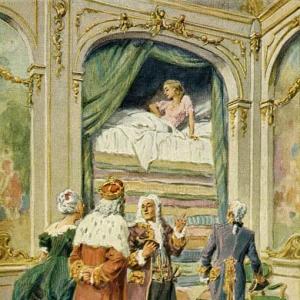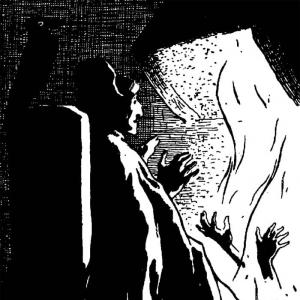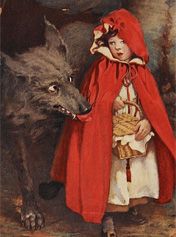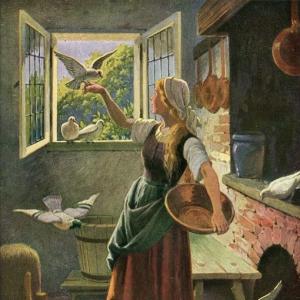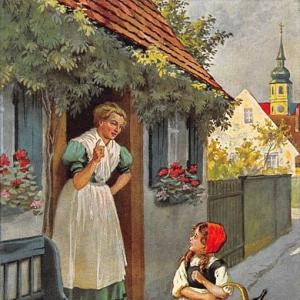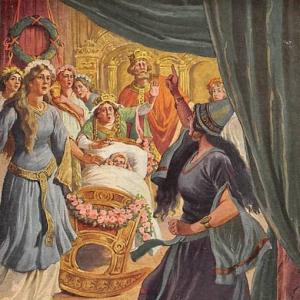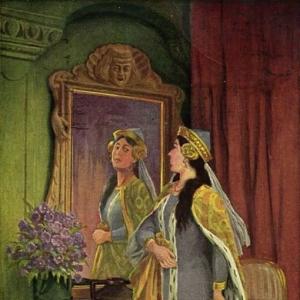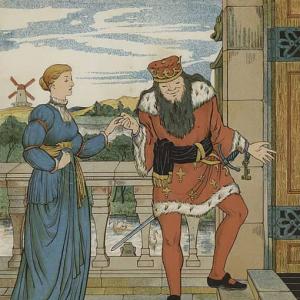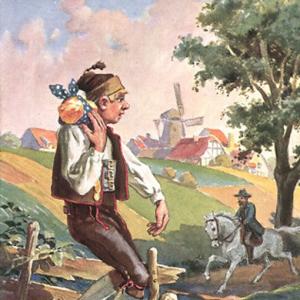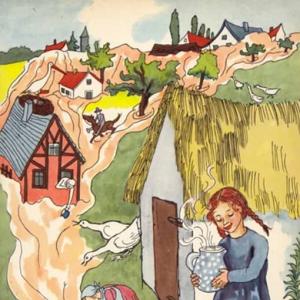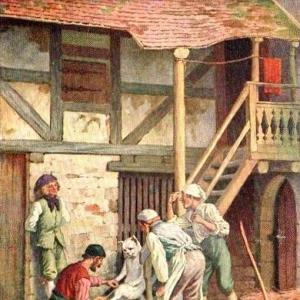Reading time: 5 min
In the Garden of Paradise, beneath the Tree of Knowledge, bloomed a rose bush. Here, in the first rose, a bird was born. His flight was like the flashing of light, his plumage was beauteous, and his song ravishing. But when Eve plucked the fruit of the tree of knowledge of good and evil, when she and Adam were driven from Paradise, there fell from the flaming sword of the cherub a spark into the nest of the bird, which blazed up forthwith.
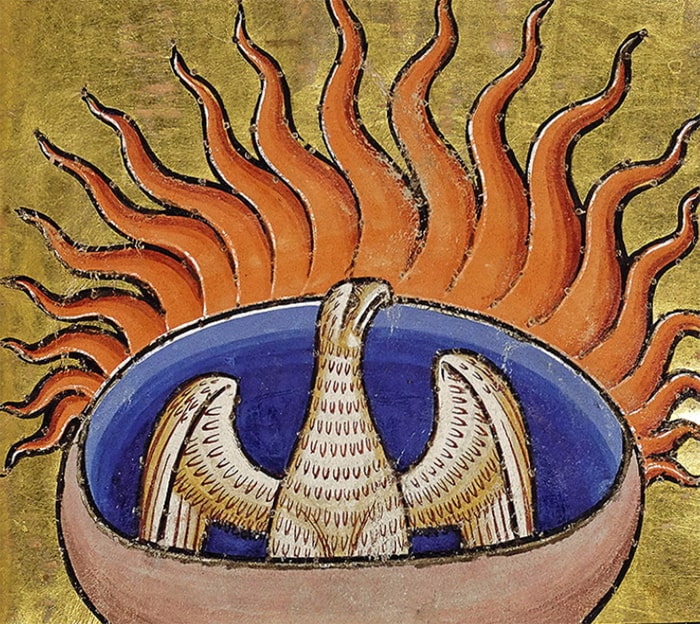
The bird perished in the flames; but from the red egg in the nest there fluttered aloft a new one – the one solitary Phoenix bird. The fable tells that he dwells in Arabia, and that every hundred years, he burns himself to death in his nest; but each time a new Phoenix, the only one in the world, rises up from the red egg.
The bird flutters round us, swift as light, beauteous in color, charming in song. When a mother sits by her infant’s cradle, he stands on the pillow, and, with his wings, forms a glory around the infant’s head. He flies through the chamber of content, and brings sunshine into it, and the violets on the humble table smell doubly sweet.
But the Phoenix is not the bird of Arabia alone. He wings his way in the glimmer of the Northern Lights over the plains of Lapland, and hops among the yellow flowers in the short Greenland summer. Beneath the copper mountains of Fablun, and England’s coal mines, he flies, in the shape of a dusty moth, over the hymnbook that rests on the knees of the pious miner. On a lotus leaf he floats down the sacred waters of the Ganges, and the eye of the Hindoo maid gleams bright when she beholds him.
The Phoenix bird, dost thou not know him? The Bird of Paradise, the holy swan of song! On the car of Thespis he sat in the guise of a chattering raven, and flapped his black wings, smeared with the lees of wine; over the sounding harp of Iceland swept the swan’s red beak. On Shakspeare’s shoulder he sat in the guise of Odin’s raven, and whispered in the poet’s ear „Immortality!“ and at the minstrels‘ feast he fluttered through the halls of the Wartburg.
The Phoenix bird, dost thou not know him? He sang to thee the Marseillaise, and thou kissedst the pen that fell from his wing. He came in the radiance of Paradise, and perchance thou didst turn away from him towards the sparrow who sat with tinsel on his wings.
The Bird of Paradise – renewed each century – born in flame, ending in flame! Thy picture, in a golden frame, hangs in the halls of the rich, but thou thyself often fliest around, lonely and disregarded, a myth – „The Phoenix of Arabia.“ In Paradise, when thou wert born in the first rose, beneath the Tree of Knowledge, thou receivedst a kiss, and thy right name was given thee– thy name, Poetry.
 Learn languages. Double-tap on a word.Learn languages in context with Childstories.org and Deepl.com.
Learn languages. Double-tap on a word.Learn languages in context with Childstories.org and Deepl.com.Backgrounds
Interpretations
Adaptions
Summary
Linguistics
„The Phoenix Bird“ is a short fairy tale written by Danish author Hans Christian Andersen, who is best known for his classic stories such as „The Little Mermaid,“ „The Ugly Duckling,“ and „The Snow Queen.“ Andersen was born on April 2, 1805, in Odense, Denmark, and died on August 4, 1875, in Copenhagen.
Throughout his career, Andersen wrote numerous fairy tales, many of which have become an integral part of Western children’s literature and have been adapted into various forms of media, such as film, theater, and television. Although his stories were initially intended for children, they have been recognized for their profound themes and their appeal to readers of all ages.
„The Phoenix Bird“ is not one of Andersen’s most famous works, but it is an interesting story that touches on themes such as rebirth, resilience, inspiration, and the transcendent nature of art and poetry. The Phoenix, a mythical bird that rises from its own ashes, serves as a powerful symbol throughout the tale, representing the eternal and transformative power of creativity.
Andersen’s fairy tales are known for their vivid imagery, emotional depth, and moral messages. In „The Phoenix Bird,“ the author uses the bird as a metaphor for poetry, emphasizing the importance of recognizing beauty and inspiration in the world around us. The story invites readers to appreciate the divine qualities of art and the resilience of the human spirit, as embodied by the Phoenix.
„The Phoenix Bird“ by Hans Christian Andersen offers several interpretations, reflecting different aspects of life, art, and spirituality. Here are some possible interpretations of the tale.
The power of rebirth and transformation: The Phoenix is a symbol of rebirth and transformation, as it rises anew from the ashes of its own destruction. This can be seen as a metaphor for personal growth and change, illustrating that we can overcome challenges and setbacks to emerge stronger and wiser.
The eternal nature of art and creativity: The Phoenix represents poetry, a divine art form that has the power to inspire and endure throughout the ages. Just as the Phoenix is reborn every century, art and creativity continue to thrive and reinvent themselves, transcending the boundaries of time and culture.
The beauty and ubiquity of inspiration: The story shows that the Phoenix can be found in various cultures and environments, symbolizing the universality of inspiration and the power of beauty to uplift the human spirit. It highlights the importance of recognizing and appreciating beauty in all its forms.
The resilience of the human spirit: The Phoenix’s ability to rise from its ashes can be seen as a metaphor for the human spirit’s resilience in the face of adversity. The tale serves as a reminder that even in difficult circumstances, we have the strength to overcome challenges and grow from our experiences.
The importance of recognizing the extraordinary in the ordinary: The tale encourages us to see the beauty and wonder in everyday experiences, urging us not to overlook the Phoenix’s presence in our lives in favor of more superficial, less meaningful attractions. By being open to inspiration and beauty in our daily lives, we can deepen our connection to the divine and experience the transformative power of art and creativity.
Hans Christian Andersen’s fairy tale „The Phoenix bird“ has inspired many adaptations and retellings over the years. Here are some notable examples.
The Firebird: This Russian fairy tale, which also features a magical bird with the power of rebirth, is thought to have influenced Andersen’s story. Many adaptations of „The Phoenix bird“ draw on elements of the Firebird tale, including the ballet by Igor Stravinsky.
The Arabian Nights: In „The Arabian Nights,“ there is a story called „The Peri and the Phoenix“ that shares many similarities with Andersen’s tale. In this version, a young prince sets out on a quest to capture the magical Phoenix and bring it back to his father’s kingdom.
Disney’s Fantasia 2000: „The Firebird Suite“ segment of this animated film is based on Stravinsky’s ballet, which in turn drew on elements of the Phoenix myth. The segment features stunning animation and tells the story of a forest spirit that brings new life to a barren landscape.
The Phoenix and the Carpet: This children’s novel by E. Nesbit features a magical Phoenix that helps a group of siblings on their adventures. The Phoenix’s power of rebirth plays a key role in the story.
X-Men: The character Jean Grey, also known as Phoenix, was named after the mythical bird and shares its power of rebirth. In the X-Men comics and movies, Jean Grey’s transformation into the Phoenix is a key storyline.
The Phoenix’s Riddle: This children’s book by Claire Llewellyn retells Andersen’s story with a twist. In this version, a young girl must solve the Phoenix’s riddle in order to save her father’s kingdom from destruction.
Overall, „The Phoenix bird“ has inspired a wide range of adaptations and retellings across various media, from ballet and animation to children’s literature and superhero comics.
„The Phoenix Bird“ by Hans Christian Andersen is a fairy tale that tells the story of a unique, mythical bird born in the Garden of Paradise beneath the Tree of Knowledge. The bird is born from a rose bush and possesses extraordinary beauty, speed, and song. When Adam and Eve are banished from Paradise, a spark from a cherub’s flaming sword ignites the bird’s nest, and it perishes in the fire. From the ashes, however, a new Phoenix is born, the only one of its kind in the world. It is said that the Phoenix lives in Arabia and burns itself to death every hundred years, only to rise again from the ashes.
The Phoenix is not just a bird of Arabia. It can be found all around the world, bringing light and beauty to different places and cultures. The bird symbolizes various things, such as a mother’s love for her child, the happiness in a contented home, or the sacredness of religious devotion. In the presence of great poets and artists like Thespis, Shakespeare, and others, the Phoenix takes various forms and whispers the promise of immortality.
The Phoenix Bird represents poetry, a divine art born in Paradise, and it continues to inspire and bring beauty to the world. Although it may often be overlooked or disregarded, it remains a powerful symbol of creativity, rebirth, and the eternal nature of art.
The fairy tale „The Phoenix Bird“ by Hans Christian Andersen is rich in metaphor and symbolism, exploring themes of creation, destruction, and renewal through the legendary figure of the Phoenix. Linguistic analysis of the text reveals Andersen’s use of vivid imagery, mythological allusions, and allegorical elements to convey the story’s deeper meanings.
Vivid Imagery
Andersen employs vivid imagery to evoke a sense of wonder and beauty surrounding the Phoenix. Phrases like „flight was like the flashing of light,“ „beauteous plumage,“ and „song ravishing“ emphasize the bird’s enchanting presence. These descriptions create a picture of an ethereal creature that transcends ordinary experience, inviting readers to visualize its magnificence.
Mythological Allusions
The tale is replete with mythological allusions, drawing from various cultural traditions. The Phoenix’s origin „beneath the Tree of Knowledge“ and its connection to the „flaming sword of the cherub“ directly link the story to the biblical narrative of Adam and Eve. The reference to Thespis, the car of Thespis, and Odin’s raven extend the mythological scope, incorporating elements from Greek mythology and Norse legends, respectively. These allusions serve to position the Phoenix as a universal symbol of rebirth and transformation across different cultural contexts.
Allegory and Symbolism
Central to the tale is the allegorical representation of the Phoenix as the embodiment of poetry and artistic creation. The narrative explicitly draws parallels between the bird and the concept of poetry, suggesting that both are born anew from the ashes of their predecessors. By naming the Phoenix „Poetry“ and associating it with the likes of Shakespeare and the celebration of the Marseillaise, Andersen elevates the Phoenix to a symbol of artistic immortality and the enduring power of creative expression.
Transcultural Presence
The Phoenix’s presence across various geographical regions—Arabia, Lapland, Greenland, England, and India—suggests its transcultural nature. Andersen’s depiction of the Phoenix flitting across diverse landscapes signifies the ubiquity and timelessness of its essence. It encapsulates the idea that the themes of rebirth and beauty are universal, transcending geographical and cultural boundaries.
Contrast and Irony
Andersen introduces a sense of irony by contrasting the Phoenix’s divine and transcendent qualities with the mundane and sometimes unappreciated existence it leads. Although depicted as „a myth,“ „lonely and disregarded,“ and overshadowed by the „sparrow with tinsel on his wings,“ the Phoenix—as poetry—speaks to the often overlooked yet profound impact of art and literature in society. This irony underscores the dichotomy between outward appearances and intrinsic value.
Overall, Hans Christian Andersen’s „The Phoenix Bird“ uses linguistic devices to weave a rich tapestry of meaning. Through vivid imagery, mythological references, allegorical depth, transcultural motifs, and ironic contrasts, he crafts a narrative that celebrates the cyclical nature of life, art, and the enduring human spirit.
Information for scientific analysis
Fairy tale statistics | Value |
|---|---|
| Translations | DE, EN, DA, ES, NL |
| Readability Index by Björnsson | 36.1 |
| Flesch-Reading-Ease Index | 75.1 |
| Flesch–Kincaid Grade-Level | 8 |
| Gunning Fog Index | 9.3 |
| Coleman–Liau Index | 9 |
| SMOG Index | 8.9 |
| Automated Readability Index | 8.9 |
| Character Count | 2.746 |
| Letter Count | 2.121 |
| Sentence Count | 24 |
| Word Count | 504 |
| Average Words per Sentence | 21,00 |
| Words with more than 6 letters | 76 |
| Percentage of long words | 15.1% |
| Number of Syllables | 658 |
| Average Syllables per Word | 1,31 |
| Words with three Syllables | 23 |
| Percentage Words with three Syllables | 4.6% |

 Facebook
Facebook  Whatsapp
Whatsapp  Messenger
Messenger  Telegram
Telegram Reddit
Reddit